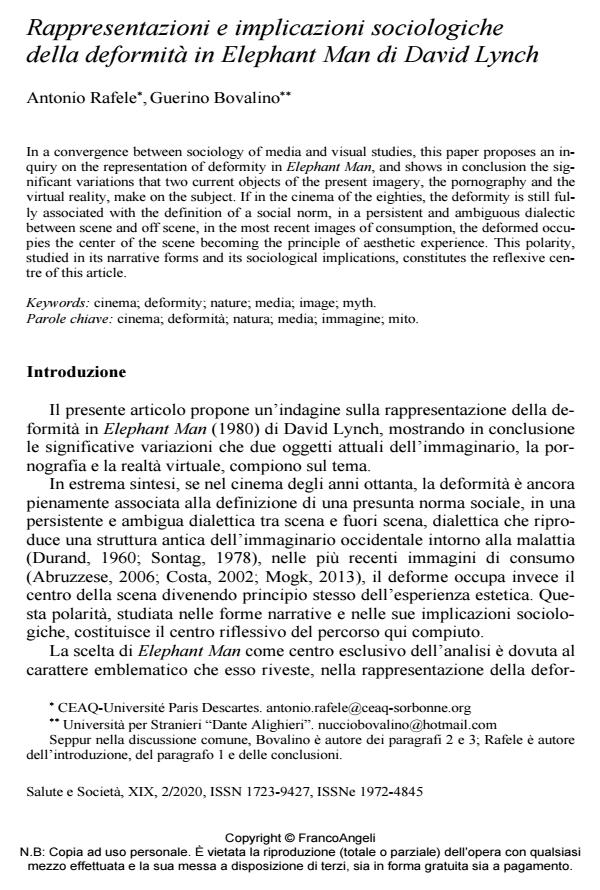Rappresentazioni e implicazioni sociologiche della deformità in Elephant Man di David Lynch
Titolo Rivista SALUTE E SOCIETÀ
Autori/Curatori Antonio Rafele, Guerino Bovalino
Anno di pubblicazione 2020 Fascicolo 2020/2 Lingua Italiano
Numero pagine 12 P. 44-55 Dimensione file 148 KB
DOI 10.3280/SES2020-002004
Il DOI è il codice a barre della proprietà intellettuale: per saperne di più
clicca qui
Qui sotto puoi vedere in anteprima la prima pagina di questo articolo.
Se questo articolo ti interessa, lo puoi acquistare (e scaricare in formato pdf) seguendo le facili indicazioni per acquistare il download credit. Acquista Download Credits per scaricare questo Articolo in formato PDF

FrancoAngeli è membro della Publishers International Linking Association, Inc (PILA)associazione indipendente e non profit per facilitare (attraverso i servizi tecnologici implementati da CrossRef.org) l’accesso degli studiosi ai contenuti digitali nelle pubblicazioni professionali e scientifiche
;
Keywords:Cinema; deformità; natura; media; immagine; mito.
- Abruzzese A. (2006). L’occhio di Joker. Cinema e modernità. Roma: Carocci.
- Abruzzese A. (2015). Punto zero. Il crepuscolo dei barbari. Roma: Sossella.
- Belting H. (2001). Bild-Anthropologie. Entwürfe für eine Bildwissenschaft. München: Fink.
- Benjamin W. (1983). Das Passagen-Werk. Frankfurt am Main: Suhrkamp.
- Benjamin W. (1996). Zur Kritik der Gewalt. In Gesammelte Schriften, Vol. II.1. Frankfurt am Main: Suhrkamp.
- Byung-chul H. (2013). Digitale Rationalität und das Ende des kommunikativen Handelns. Berlin: Matthes & Seitz.
- Byung-chul H. (2016). Die Austreibung des Anderen: Gesellschaft, Wahrnehmung und Kommunikation heute. Frankfurt: Fischer.
- Calleja G. (2011). In-Game. From Immersion to Incorporation. Cambridge: MIT Press.
- Codeluppi V. (2000). Lo spettacolo della merce: i luoghi del consumo dai passages a Disney World. Milano: Bompiani.
- Codeluppi V. (2013). Mostri. Dracula, King Kong, Alien, Twilight e altre figure dell'immaginario. Milano: Franco Angeli.
- Costa A. (2002). Il cinema e le arti visive. Torino: Einaudi.
- Crary J. (2000). Suspensions of Perception: Attention, Spectacle and Modern Culture. Cambridge: MIT Press.
- Durand G. (1960). Les structures anthropologiques de l'imaginaire. Grenoble: Allier.
- Hansen M. B. N. (2007). Bodies in Code: Interfaces with Digital Media. New York: Routledge.
- Illouz E. (2008). Saving the Modern Soul: Therapy, Emotions, and the Culture of Self-Help. Berkeley: University of California Press.
- McLuhan M. (1964). Understanding media. New York: McGraw Hill.
- Mogk M. E. (2013). Different bodies. Essays on disability in film and television. Jefferson: McFarland Publisher.
- Morton T. (2007). Ecology Without Nature: Rethinking Environmental Aesthetics. Cambridge: Harvard University Press.
- Morton T. (2013). Hyperobjects: Philosophy and Ecology after the End of the World. Minnesota: University of Minnesota Press.
- Norden M. F. (1994). The cinema of isolation: A history of physical disability in the movies. New Brunswick: Rutgers University Press.
- Peters J. D. (1999). Speaking Into the Air: A History of the Idea of Communication. Chicago: University of Chicago Press.
- Sontag S. (1978). Illness as Metaphor. New York: Macmillan Publishers.
- Williams L. (2004). Porn studies. Durham: Duke University Press.
Antonio Rafele, Guerino Bovalino, Rappresentazioni e implicazioni sociologiche della deformità in Elephant Man di David Lynch in "SALUTE E SOCIETÀ" 2/2020, pp 44-55, DOI: 10.3280/SES2020-002004